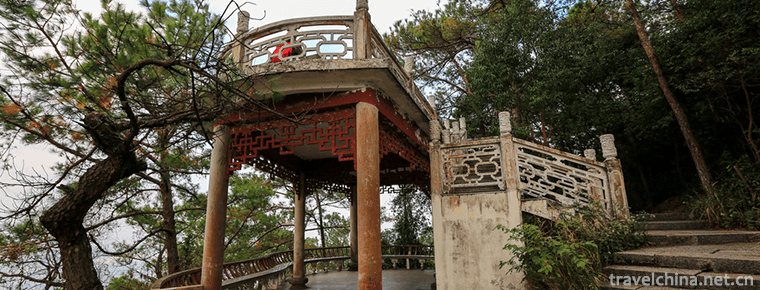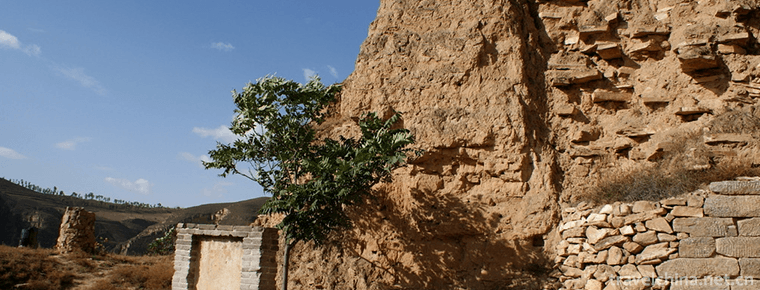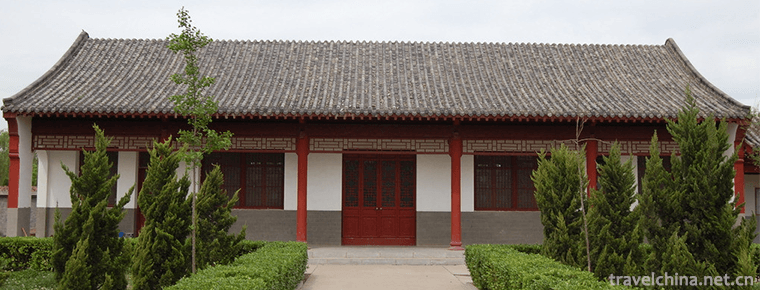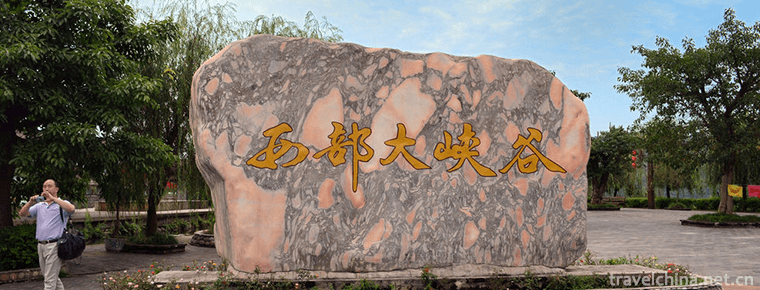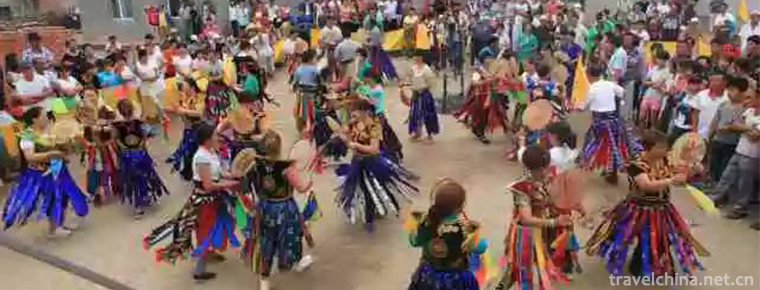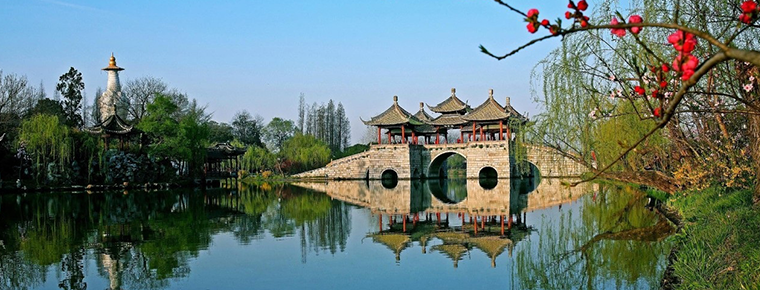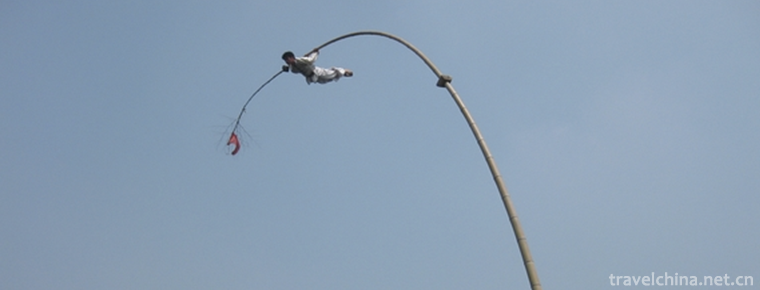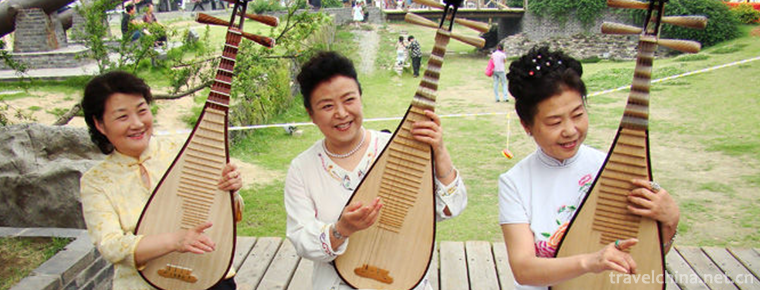Donglin Temple
Donglin Temple, located at the foot of Lushan Mountain, Jiujiang City, Jiangxi Province, is 16 kilometers north of Jiujiang City and 50 kilometers east of Lushan Luling Street. Because it is east of Xilin Temple, it is named Donglin Temple.
Donglin Temple was built in the ninth year of Dayuan in the Eastern Jin Dynasty (384), and it is one of the oldest monasteries on Lushan Mountain. Donglin Temple is the birthplace of Buddhism Pure Land Sect (also known as Lotus Sect), and is also regarded as ancestral court by Japanese Buddhism Pure Land Sect and Pure Land Sect.
In 1983, it was listed by the State Council as one of the three major international exchange venues of Buddhism in the Han nationality region: the national key monastery of Buddhism, the national famous Buddhist monastery and Jiangxi Province.
Since its construction, Donglin Temple has a history of more than 1600 years till 2014. It has experienced many vicissitudes and repeated failures.
Historical evolution
Donglin Temple is the birthplace of Buddhism (Pure Land Sect). It is also regarded as the ancestral court of Japanese Buddhism Pure Land Sect and Pure Land Sect.
In the first year of Taihe in the Eastern Jin Dynasty (366 AD), Taofan of Xunyang, Guangluqing, built Xilin Temple for Master Huiyong.
In the eighth year of Taiyuan in the Eastern Jin Dynasty (383), Master Huiyuan practised an appointment with Master Huiyong to go to Luofu Mountain in Guangdong Province for a burial study. After passing through Xunyang, he saw that Lushan was quiet enough to rest, retained Longquan Jingshe, and then moved to Xilin.
In the ninth year of Taiyuan (384), Huanyi was appointed as the assassin of Jiangzhou. He accepted Huiyong's proposal to build Donglin Temple for Huiyuan.
In the eleventh year of Taiyuan (386), Donglin Temple was built. Huiyuan lived in Donglin Temple since then.
In the seventeenth year of the Taiyuan Dynasty (392), Huiyuan did not possess many Buddhist scriptures. He sent his disciples Fa Jing and Fa to seek Buddhism in the Western Regions, and then retrieved many Sanskrit scriptures. On July 28, one hundred and twenty-three people, Huiyuan and Liu Yimin, joined Bailian Club in an attempt to survive in the West and asked Liu Yimin to write a "Vow Paper".
When Shi Mo Liuzhi came to Guanzhong, Huiyuan sent his disciples to write and pray for the translation of the original part of the Ten Chanting Laws. Huiyuan sent a letter to Cuomorosh, asking the Mahayana Essentials, and Cuomorosh answered them one by one.
In the sixth year of Yixi (410 years), Buddhist Buddhist Buddha Pu Ba Da Ra of Jinbin entered Lushan Mountain and was invited by Huiyuan to translate the Sutra of Convenient Zen Practice. Huiyuan made a preface and praised it.
In the twelve years of Yixi (416), Huiyuan died in Donglin Temple. Xunyang Taishou Ruan Kan built tombs, Xie Lingyun built inscriptions, Zong Bing erected monuments.
Liang Taiqing-zhong (547-549) reopened the manna ring altar and followed Huiyuan's way of preaching the Golden Light Sutra in the forest.
During the twelve to fifteen years (592-595) of Kaihuang in Sui Dynasty, Master Zhiyi of Tiantai Zong lived in Donglin. At the request of the monks, he wrote a book and Yang Guang, King of Jin (Emperor Yangdi of Sui Dynasty), asked for "permanently forbidding public and private parking" to facilitate monks to gather for retreat. Yang Guang, at his request, has been ordered to execute.
During the reign of Zhenguan in Tang Dynasty, Emperor Taizong visited Donglin Temple and inscribed the tablet "Smart Spring".
In the Ninth Year of Tang Taihe (835), Bai Juyi hid 60 volumes of his anthology in Donglin Jingzang. Later, ten volumes of the anthology were returned to the temple, along with the statues of Xiangshan Buddhists.
In the twelfth year of Baoda University (954), he built the Tuoba Rashalita, which was written by Pengbin. Afterwards, 500 Luohan cast iron masters of Li in the Southern Tang Dynasty were sent to Donglin Temple, where the monks built pavilions to worship them.
In the second year of Yuanfeng in Northern Song Dynasty (1079), Shenzong commanded Donglin to be a Buddhist temple, while Wang Shao, Taishou in Nanchang, was always a resident of Donglin.
In the third year of Yuanfeng (1080), the great painter Li Gonglin (No. Longmian) drew "Eighteen Talents" for Donglin.
In the seventh year of Yuanfeng (1084), Su Shi and Huang Tingjian, the great writers, were always accompanied by them to visit the scenic spots of Donglin. Su Shi wrote the sentence "Su Donglin Temple is a master of Zen".
In the second year of Shaoxing in the Southern Song Dynasty (1132), Yue Fei, a national hero stationed in Tunjiujiang, wrote poems to Donglin Huihai, who urged Huihai to "rebuild the lotus club" in order to die in the future.
In the ninth year of Dade in Yuan Dynasty (1305), Pudu, the chief monk of Lianzhong Shanfa Tang in Donglin Temple, wrote ten volumes of Lianzhong Baojian, which was published and circulated both at home and abroad.
In the fifteen years of Zhengde in Ming Dynasty (1520), Wang Shouren (No. Yangming), a great philosopher, visited Donglin Temple and wrote seven-character poems, whose stone carvings were embedded in the walls of Sanxiaotang.
In the fifteenth year of Guangxu (1889), Kang Youwei visited Donglin Temple. He saw various pieces of inscriptions and tablets mixed under the kitchen. Among them, the remnants of inscriptions written by Liu Gongquan instructed the monks to keep them properly.
In Guangxu 26 years (1900), the buildings of Donglin Temple were largely restored. The three characters of "Donglin Temple" in Shanmen are written by Kang Youwei in his old travels.
During the four years of the Republic of China (1915), Donglin Abbot Miaoli rebuilt Wenshu Pavilion and placed the inscription of Sanxiao Tu presented by Peng Zunian beside the wooden pool.
In the twenty-third year of the Republic of China (1934 Niu), the "Lushan Huiyuan Master's Notes" compiled by Shajian'an Institute in Jiangsu Province was first published and circulated. In the winter of the same year, the inner wall of Yuangong Shadow Hall was embedded with the image of 18 high stone carvings.
In 1967, Donglin Temple suffered from the "Cultural Revolution" disaster, Buddha statues and magic vessels were smashed, the Ming Dynasty "Diamond Sutra" bronze tower was demolished, scrap sold, monks scattered, and Guyi Master sent Jiufeng reclamation farm.
In 1978, the Lushan Administration decided to restore the Donglin Temple. On June 18, Master Guoyi was invited to return to Donglin and assume the responsibility of presiding over it. In the same year, with the approval of Jiangxi Provincial People's Government, Donglin Temple was listed as a key cultural relic protection unit in the whole province, and was officially opened as the first Buddhist shrine in the whole province at home and abroad.
In 1983, the Huiyuan Pagoda Court and the Buddha Tuoba Rashali Pagoda were rebuilt. On the following year's Buddha's birthday, two pagodas were held to celebrate the opening of the Great Canon. The Japanese Pure Land Sect visited the delegation of Dogawa and Suzuki Shinkuang to attend the grand ceremony, and presented Dazheng Xinxiu Dazang Sutra.
In 1983, it was listed by the State Council as one of the three major international exchange venues of Buddhism in the Han nationality region: the national key monastery of Buddhism, the national famous Buddhist monastery and Jiangxi Province.
In 1984, the Daxiong Palace was rebuilt with the support of the eminent monks at home and abroad and completed in 1989.
In 1990, Donglin Temple celebrated the completion of Daxiong Palace.
In 1990, Lianchi was rebuilt. On October 1 of the same year, Fujintang, chairman of the Japan-China Friendship Pure Land Sect Association and professor of Buddhist University, made a special trip to return the seeds of white lotus originally introduced from Donglin to Zuting.
In 1991, the Lotus Fair was held in Donglin Temple to celebrate the revival of the ancestral courtyard and the reappearance of the lotus pond.
On June 1, 1992, Donglin Temple held the celebration of the establishment of the Lotus Society and the establishment of the Law Society of the Lushan Linjingtuzong Culture Research Association.
On February 28, 1993, the Jiangxi Buddhist Academy, founded by Donglin Temple, officially opened. Guo Yizhang was also the president. In summer, the first Lushan Buddhist College Summer Camp was held. In autumn, the Manna Ritual was reopened to teach the Great Ritual of Thousand Buddhas.
During the Spring Festival of 1994, the Master Guoyi led the public to build a 48-meter image of Amitabha Buddha.
At 4:10 on March 6, 1994, the first man died.
In the autumn of 1994, the great monk was stationed in Xidonglin and promoted to abbot.
In September 2003, Master Da'an was entrusted by the Indian monk as the abbot of Donglin Temple, presiding over the work of Donglin Temple in an all-round way.
geographical position
Donglin Temple, located at the northern foot of Lushan Mountain, is the birthplace of Pure Land Sect of Buddhism in China. It was founded by Huiyuan, a famous monk of the Eastern Jin Dynasty, in 386 A.D., and is one of the temples with a long history in Lushan Mountain. During the Han and Tang Dynasties, it became one of the Eight Avenues of Buddhism in China. Jianzhen, a prominent monk in the Tang Dynasty, brought the doctrine of Donglin into Japan. Today, Huiyuan is still the ancestor of Donglin religion in Japan. Now the temple halls and smart springs and other attractions have been restored.
Main landscape
Front door
There is Pure Land Cultural Street in front of Shanmen, which is used for logistical services, psychological counseling, dissemination of Chinese culture, vegetarian culture and so on. Shanmen Dian District is located at the southern end of the central axis of the Dafoyuan Architectural Complex, and the main hall is the Tianwang Dian.
Hall of Heavenly Kings
The Tianwangdian Temple is adjacent to the Huanlu Mountain Highway. A five-way stone archway is designed as a barrier to form the southern boundary of the park. Through the archway, there are four trees and eight pillars arranged on the lawn platform, and white elephant stone carvings are set around the mountain gate. An entrance space is ingeniously constructed by aconitum gate type shadow wall and mountain gate, as well as the auxiliary halls on the front and front sides of the mountain gate. The parking lot in the entrance area is behind the compartments on both sides of the central axis. In the Temple of Heavenly Kings, the four great heavenly kings, Maitreya Bodhisattva, Wei Pu Bodhisattva, are worshipped to form the first landscape.
Three Temple
The Sanshengdian area is 90 meters long, with Qibao lotus pool as its core, and the main hall is connected with the corridor to form a layout similar to the Wufeng Tower in the Wumen Gate of the Palace Museum. It not only implies a broad mind with open arms, but also reproduces the flourishing scenes of the eight merits and virtues of the Pure Land Monastery and the pavilions and pavilions in the flourishing Tang Dynasty. The temple is dedicated to Amitabha Buddha and the image of Guanyin and Shi to the two great Bodhisattvas. There are murals of Pure Land Change, which create a happy and happy atmosphere in the Western Buddhist kingdom. They are annotated and rendered around the theme of "lead-in".
Main hall
The total length of Daxiong Palace is 180 meters, and there are two districts to distribute the palace. One is centered on the Buddhist Shrine Pagoda. There are corridors and halls around the pagoda. In the pagoda, Buddha's real relics are worshipped. Believers are offered spiritual cultivation around the pagoda. They pay tribute to the relics, remember Buddha's merits and give birth to the good roots of Buddha. The second is the area where the Daxiong Palace is connected with the supporting palace. The main hall is the Heavy Eaves Hall, with seven deep halls and nine flat planes. It is the largest hall on the central axis. The rear of Daxiong Palace is directly opposite to the climbing steps, which fluctuate and extend. In the meantime, a pavilion can be set up to stop and rest, as well as to have a long view of the fence. It can be enjoyed to know its true face outside Lushan Mountain.
Buddha's desk
The Buddha-worship terrace is located in the middle of the steps to the Buddha. The terrace is equipped with sculptures with the theme of offering. It can look forward to the Buddha's dignity, and then back to the Three Saints'Hall and the Temple of Heavenly Kings. Taizhong is mainly used for offering and worshipping Buddha.
The approach bridge is skillfully supported by mountain valleys and streams. The bridge body is arched, such as the flying rainbow in the sky. The bridge fence sculpture and the bridge channel embody the "White Road Metaphor of the Second River of Water and Fire". The bridge is designed with Lianhua pattern, step by step Lianhua, tending to the other side of Amitabha Buddha. Hundred Birds Valley under the bridge is the habitat of birds, birds singing together, praise Buddha.
Take over the guide, meaning to the other side of bliss. There are stone carvings welcomed by two Bodhisattvas at the bridge head, golden ground at the foot (copper road), and simulated seven treasure lands around the bridge, indicating that they have wandered on the paradise ground. Next is the paradise road, the fence has the pure land pattern, the stigma has the paradise lotus flower and the Carling Banga pattern. At the end, there are copper reliefs of "Hometown Wind Moon", along the Great Buddhist Platform along the left and right circular road.
Tai Buddha Tai
The Grand Buddha Terrace is a simple and solemn mandala, 48 meters for the main Buddha, 6 meters for the Lotus Terrace and 81 meters for the Baogai. There are two platforms, the first one is 10,000 square meters, with corridors around it. There are nine stone carvings of the past and twelve light Buddha carvings in Xumaitai, with famous stone tablets of merit and virtue behind them. The second floor is 6,000 square meters, where the Buddha is located. In front of the Great Buddha, there are Guanyin and Shizhi, which form the pattern of three saints in the West. On the first floor, there is a bronze sculpture of Buddha on the lotus terrace, where the monk is guided to kneel and clap his hands. There are eight diamond guards under Xumi's seat, and two-story white marble balustrade of Dafotai. The weather is magnificent and solemn.
Behind the Great Buddha Tai, there is a platform on the top of the mountain, forty-eight pillars of wishes are set up, and forty-eight wishes are carved to form a huge energy field. It is surrounded by long corridors, which can be used by followers to practise Buddhism.
There is a space of 7,000 square meters under the platform of the Great Buddha, which is used as the exhibition hall of Pure Land Culture. It displays Pure Land Confucianism, Pure Land Inheritance, the solemnity of the blissful world, Buddhist principles and induction, the biography of the thirteenth ancestors of the Pure Zone, past life examples, the relationship between Pure Land Law and Chinese culture, etc. It makes pedestrians have a systematic and detailed understanding of Pure Land Culture.
The 3,300-acre Donglin Temple Pure Land Garden is mainly laid out with the concept of a monastery. In addition to rendering the religion of the Pure Industry pedestrians to Amitabha Buddha in the Great Buddha Chao ritual area, other study areas try to be simple and plain.
Out log pond
Legend has it that at the beginning of Donglin Temple, Master Huiyuan was worried about raising timber. One day, when Far Gong slept until midnight, in his dream, he saw an old man with white beard who called himself "the God of Lushan Mountain". He said to Far Gong, "This place is quiet enough to live in." That night, thunder and lightning in the sky, storms and storms, until daybreak, when a look, in front of the palace pond has gushed out a lot of good timber, to solve the urgent need of Master Huiyuan. All of these are from Master Huiyuan's sincere view of heaven and earth, virtue and spiritual feeling, so there is this God's help. Later, Master Huiyuan named the palace built with this timber as "Shenyun Palace", and the pond where the timber gushed out was called "Out of Wood Pond".
bright springs
After the Jade Buddha Tower in Donglin Temple, there is a clear spring called "Smart Spring" which never dries up in all seasons. Legend has it that Yin Zhongkan, a famous general of the Eastern Jin Dynasty, visited Master Huiyuan at Donglin Temple. They traveled to the foot of the mountain and saw the green pines and cypresses and the ripples of spring water here, so that they could listen to the spring and talk about Yi. General Yin was knowledgeable and eloquent. Master Huiyuan pointed to Quan Zan and said, "The debate among generals is so flowing that the emperor is wise, if it is fountain!" This spring is named "Smart Spring". Taizong of Tang Dynasty wrote the word "smart spring" in calligraphy, and Pi Rixiu, a famous poet in the late Tang Dynasty, also had a poem cloud: "A spoon like Qiongye will fool sages and sages. A constant desire for knowledge is like a fountain of greed." Later per capita inscribed monuments. Until now, many visitors to Donglin Temple have to drink a spoonful of "smart spring" water, which is a good hope for people to pursue wisdom.
Yuan Gong Ta Yuan
On the west side of Donglin Temple, Yuangong Pagoda is dedicated to the Tomb Pagoda of Master Huiyuan. Master Huiyuan, commonly known as Jia, was born in Yanmen Lou Fan (now Ningwu, Shanxi Province). Born in Xianhe, Emperor Chengdi of the Eastern Jin Dynasty (334). Master's family is a Confucian family, he is young and eager to learn, Wei Zhang hair, comprehensive six classics, especially "Lao" and "Zhuangzhuang". Yonghe Ten Years (354 years) in the Eastern Jin Dynasty, he was 21 years old. He was supposed to be concealed with Fan Xuanzi, a master of Confucian classics. As a result of the Civil War, roads were blocked and the South was not achieved. Hearing that Master Dao'an preached in Hengshan, Taihang, he went with his brother. Wen An said the Prajna Sutra, enlightened suddenly and became a monk resolutely. Master Huiyuan practiced Buddhism, translated scriptures and preached Buddhism. His academic character was praised and he was recognized as the leader of Buddhism. He established Donglin Daochang, formed Bailian Club with 123 senior monks and sages, studied Buddha diligently, vowed to live in the West, opened the line of the Chinese Pure Zone, and was respected as the first ancestor of the Pure Zone. Master Huiyuan died in the twelve years of Yixi in the Eastern Jin Dynasty (416 years). The later generations built the pagoda to worship it. It was also called the "Litchi Pagoda" because its tomb pagoda was stacked with stone like litchi. The old pagoda courtyard was destroyed in the Qing Dynasty. It was rebuilt in 1983 and renovated in 2000. There was a "camphor of bergamot" in the courtyard. It was said that it was planted by Master Huiyuan. It has been more than 1600 years since then.
Xilin
Lushan Linsi Temple, located at the northern foot of Lushan Mountain, was founded in the second year of Taihe in the Eastern Jin Dynasty (366 A.D.) by Taifuqing Taofan.
At first, it was a grass house in Samen, and Huiyong inherited his teaching career after his death. In the second year of the Jin and Taiyuan dynasties, Jiangzhou Tao Fan built a temple for it and named it Xilin Temple. From Jin Dynasty to Tang Dynasty, the Yuan Dynasty was burned by soldiers, Ming Xiu was destroyed, and it was never seen again for a long time. Now the temple is rebuilt, the temple is magnificent, the Buddha statue is tall, the scale is not inferior to the original, unique and solemn. In the temple, there was a wall. Su Shi visited the temple and saw many poems inscribed by his predecessors before the wall. Suo wrote "inscriptions on Xilin Wall", which was handed down as a good poem for thousands of years. Among them, "do not know the true face of Lushan" is a very philosophical sentence.
Master Hui Yong, the brother of Master Huiyuan in the Eastern Jin Dynasty, lived in Xixilin for 30 years. When Master Huiyuan first came to Lushan Mountain, he lived there. Later, he built a temple to the east of Xilin, so he was named Donglin Temple. Xilin Temple was rebuilt in 731 by Emperor Xuanzong of the Tang Dynasty. It is now a key cultural relic protection unit in Jiangxi Province.
The Xilin Pagoda behind the Xilin Temple, also known as the Thousand Buddha Pagoda, is a brick floating slaughter. Emperor Xuanzong of the Tang Dynasty built it. Ming Wang Mingyu was repaired. During the reign of Qingdaoguang (AD 1821-1850), the top of the tower cracked and healed by itself during the reign of Xianfeng (AD 1851-1861). The tower is seven stories high, hexagonal in shape, with Buddhist niches on all sides.
The bottom door opens north and south, and the front door opens south. The top of each door on the south side of the pagoda has a quota. From the bottom to the seventh floor, there are Qianfo Pagoda, Yushicai, Diamond Kong, Lingjie, Supreme Dharma, Congyuhua and Wuming Tibet. The tower is a hollow tower with Cui Wei's appearance and stands tall and steep. It is the symbol of Xilin Temple.
Six Dynasties pine
In front of the Sanxiao Hall of Song (Eastern Jin Dynasty) in the Six Dynasties, there was an ancient pine with twigs twisted and shadows whirling. Legend has it that this pine was planted by Master Huiyuan. Its original name is "Luohansong". It has been planted in the Eastern Jin Dynasty for more than 1600 years, so it is called "Six Dynasties Song". Some people also call it "the first pine in Lushan Mountain". According to legend, pine is quite spiritual, and several times of withering and prosperity are closely related to the rise and fall of Donglin: temple trees are prosperous, temple trees are withered. Now we can see that the old pine branches of the Six Dynasties are flourishing. When we know that the Chinese nation is moving to Shaolong, Donglin Zuting will revive.
Travel Tips
Admission ticket
Tickets are exempt.
Line recommendation
D1 Beishan Highway - Beishan Garden Gate - Xiaotianchi - Wangjiang Pavilion - Flower Path - such as Qinhu - Tianqiao - Jinxiu Valley - Xianrendong - Datianchi - Lulin Lake - Conference Site - Donggu Celebrity Villa - Meilu - Zhou Enlai Memorial Room - Luling Street;
D2 contains Pokou-Dakou-Botanical Garden-Wulaofeng-Triassic Spring.
bus line
1. Taxis from Jiujiang Railway Station or downtown area come to Donglin Temple. Chartered trains (not meter counting) cost about 35 yuan, and they are sent directly to the entrance of Donglin Temple. If there are many people coming, taxis are economical and convenient.
2. Take Bus 101 at Jiujiang Railway Station and get off at Shili Building. Transfer to Zhongba (3 yuan per person) in Tongyuan (or Saiyang) direction to Donglin Village intersection, which is about 1 kilometer ahead of the road.
3. Take No. 101 bus to Shili Building after getting off at Jiujiang Bus Station. The rest are the same as 2.
4. At Lushan Railway Station, taxis are available at a cost of about 25 yuan.
5. If you bring your car with you, pay attention to the road signs along the way. In some places, the signs of Donglin Temple are marked. If it is from Jiujiang to Donglin Temple, it is necessary to take a fork from Lianhua Town.









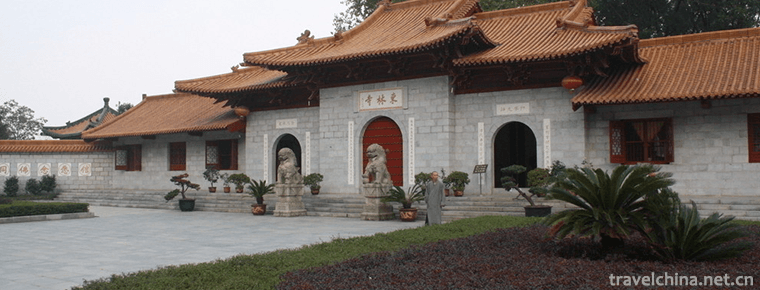
-
Tianshan Grand Canyon Scenic Area Urumqi
Tianshan Grand Canyon Scenic Area is located in Urumqi County, 48 kilometers away from the urban area. The total planned area of the scenic spot is 1038.48k.
Views: 128 Time 2018-12-12 -
Guyang Qincheng Great Wall Site
The site of the Qincheng Great Wall in Guyang is located in the Yinshan Mountains in the central part of Inner Mongolia Autonomous Region, along the Damiao, Yinhao and Xidoupu in the northern part of .
Views: 118 Time 2019-01-12 -
Hohhot Laoniuwan Tourist Area
Laoniu Bay is located at the entrance of Shanxi-Shaanxi Grand Canyon. This is the Great Wall, the only typical parallel section of the Yellow River. The widest part of the river is not more than 100 m.
Views: 159 Time 2019-01-16 -
Mengfu Mengmiao Scenic Area Meng Temple
Mencius Temple, also known as Yasheng Temple, is located at 44 Yashengfu Street, Zoucheng City, Jining City, Shandong Province, where Mencius, a thinker of the Warring States Period, was sacrificed..
Views: 173 Time 2019-02-07 -
Yicheng Temple Scenic Spot of Sun Bin Tourist City
Sun Bin Tourist City is located in Jishan Town, 20 kilometers northeast of Juancheng County, Heze City, Shandong Province. Juancheng is the hometown of Sun Bin, a famous.
Views: 79 Time 2019-02-13 -
Western Grand Canyon
Western Grand Canyon Hot Spring is a national AAAA-level tourist attraction, located in Shuifu City, Yunnan Province, 32 kilometers away from Yibin City, Sichuan Province.
Views: 120 Time 2019-02-25 -
Bo dance
Horqinbo dance, a primitive religious dance, is a form of Mongolian Bo (Shaman) "Xingbo" (Dancing God) and sacrifice. It is characterized by the combination of inspiration,.
Views: 371 Time 2019-04-04 -
Landscape Architecture in Yangzhou
Yangzhou gardens began in the Western Han Dynasty, flourished in the Sui and Tang Dynasties, matured in the Song and Ming Dynasties, and flourished in the Qianlong Period of the Qing Dynasty..
Views: 143 Time 2019-04-21 -
High bar technology
High-pole boat acrobatics is a traditional folk acrobatics project which simulates silkworm babies'silk spinning as cocoon action performed at the sacrificial ceremony of Silkworm God in Zhejiang Prov.
Views: 140 Time 2019-04-30 -
Yangzhou Tanci
Yangzhou's performance of ci-poems is mainly based on speech and supplemented by singing and playing. The representative bibliographies are "Double Gold Ingot", "Pearl Tower", &quo.
Views: 364 Time 2019-07-10 -
Girl on Bridge Hai Lun Tik Tok Songs 2020 Hot Songs
Girl on Bridge is a song composed and sung by Helen and released on November 9, 2019.
Views: 205 Time 2020-05-21 -
Meishan landform
Meishan city is high in the West and low in the East, high in the South and low in the north. The territory of mountains and horizontal, hilly ups and downs, dense river network. The central part is the broad Minjiang River valley plain. Guangdongdong mountain in Hongya.
Views: 318 Time 2020-12-18

